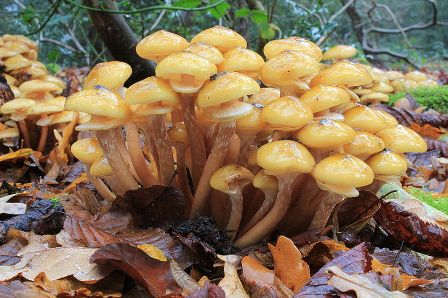- Series:God’s Design, Plants, Transcript English
2 Corinthians 9:10-11
“Now he that ministereth seed to the sower both minister bread for [your] food, and multiply your seed sown, and increase the fruits of your righteousness; Being enriched in every thing to all bountifulness, which causeth through us thanksgiving to God.”
Nearly everyone has heard of the giant fungus in Michigan’s Iron County, near the Wisconsin border. The 38-acre fungus weighs as much as a blue whale. Scientists estimate that it is about 1,500 years old, based on its current rate of growth.
 Strange life forms such as this fungus bring out the whimsy in some people. A California health food store suggested that eating some of the fungus might help people live longer. Since we at Creation Moments can’t resist living things that can be regarded as “strange,” the fungus is a natural for us. We thought that you might like to know, however, more about the Armillarias fungus and its unique life.
Strange life forms such as this fungus bring out the whimsy in some people. A California health food store suggested that eating some of the fungus might help people live longer. Since we at Creation Moments can’t resist living things that can be regarded as “strange,” the fungus is a natural for us. We thought that you might like to know, however, more about the Armillarias fungus and its unique life.
Like most fungi, Armillarias is made up of tiny tendrils growing almost invisibly underground. The honey mushrooms that sprout above ground are merely the fruiting bodies of the organism. Armillarias are commonly found in hardwood forests throughout North America. The species is territorial, which means that no two individuals will share the same area. The fungus serves a crucial purpose in the forest ecology. It breaks down dead wood for reuse by other plants. In the process, it makes carbon dioxide for the forest plants to turn into oxygen. Without the Armillarias, the forest would eventually die, choked with dead wood. God has designed the Armillarias to be a primary recycler of waste wood in the forest.
Prayer:
Father in heaven, You know our needs even before we do. I thank You that You are so generous to us. Forgive me for complaining and for having a thankless spirit. When my need seems gigantic, help me to remember that You love me and that no need is so large that You cannot provide more than enough to satisfy. In Jesus’ Name. Amen.
Notes:
John Flesher. 1992. “Humungous Fungus Tickling Funny Bones.” Kalamazoo Gazette, April 3, p. A5. Photo: Honey fungus (Armillaria mellia). Courtesy of Stu Phillips. Licensed under the Creative Commons Attribution-Share Alike 3.0 Unported license.
